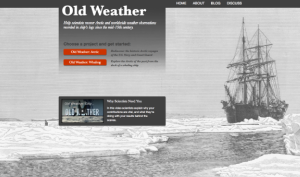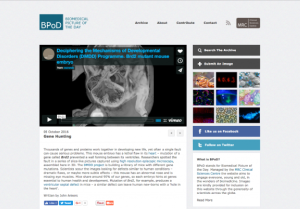Research and Education
Back to Top
|
 |
|
The Elizabeth Murray Project
|
Social studies |
|
Elizabeth Murray was born in Scotland in 1726 and moved, by herself, to Boston at the age of 22. In Boston, Murray became a successful shop owner, helped other women who wished to start businesses, and lived a remarkably independent life for an eighteenth century colonial woman. The Elizabeth Murray Project is a resource site for K-12 and college educators that features archival material and lesson plans related to Elizabeth Murray's life and work. Created by instructors at California State University, Long Beach and the Long Beach Unified School District with support from the National Endowment for the Humanities, this website includes a remarkable collection of portraits, pamphlets, trade cards, letters, newspaper articles, and legal notifications. In Teacher Resources, instructors can browse for complete lesson plans and lesson ideas by grade level (Elementary School, Middle School, High School, and University). Lesson Plan topics include Consumerism and the American Revolution; Women and Education; and Gender and Opportunity in colonial America. The Elizabeth Murray Project also features a collection of Interactive Primary Sources and a helpful Glossary help students as they navigate this site. [MMB] |
|





|
|
 |
|
open.NASA
|
Science |
|
This past year, NASA created open.NASA, an open data portal to make its extensive data sets, code repositories, and application program interfaces (APIs) available to the general public. The portal is organized so that interested visitors may easily explore the material that is most relevant to them. For instance, from the landing page, readers select the label they most identify with (Citizen Scientist, Developer, Citizen Activist, Govvie, or Curious) to see related articles and materials. While developers, scientists, and designers may want to check out the over 30,000 data sets available on this website, curious readers may be especially drawn to the Data Stories, which highlight how individuals and organizations around the world are making use of open data. [MMB] |
|





|
|
 |
|
Medieval Islamic Views of the Cosmos: The Book of Curiosities
|
Science |
|
The University of Oxford's Bodleian Library is home to a rare manuscript entitled (through a rough English translation) Book of Curiosities of the Sciences and Marvels for the Eyes. This manuscript, which was authored sometime in the eleventh century, features diagrams, maps, and text that highlight the work of Muslim astronomers, scholars, and historians, "most of which are unparalleled in any Greek, Latin or Arabic material known to be preserved today." On this website, visitors can examine a digitized copy of the first and second chapters of this five chapter manuscript. Within this sample, visitors will find diagrams of major rivers, a variety of both earthly and celestial maps, and a diagram of "winds, elements, and zodiacal signs." By moving their mouse over any portion of the digitized manuscript, readers can see the original Arabic in detail alongside an English translation. This website also includes footnotes and a glossary to aid modern day readers in examining this extraordinary document. Instructors will want to check out the project's extensive Teachers' Pack, which includes a variety of classroom activities. [MMB] |
|





|
|
 |
|
 |
|
Old Weather
|
Science |
|
Old Weather, a project from the National Oceanic and Atmospheric Administration (NOAA), is one of a growing number of crowdsourcing efforts that enlists the help of citizen scientists or citizen historians from around the world. For this specific project, volunteers are asked to help transcribe a fascinating collection of nineteenth and early twentieth century ship's logs that highlight weather, water, and ice conditions. As the About section notes, these documents are especially important because they not only help historians better understand the nature of nineteenth century voyages, but they also help contemporary climate scientists identify past weather patterns. On this website, built using the open-source tool Scribe, readers may opt to explore Arctic logs from U.S. Navy and Coast Guard voyages, or Whaling logs. Visitors can then read these entries and provide transcriptions and annotations for the project. Old Weather also features a blog that highlights a number of fascinating historical events centering on the role of weather in shipping. [MMB] |
|





|
|
 |
|
British Art Studies
|
Arts |
|
British Art Studies is an online, open access art history journal published by the Paul Mellon Centre for Studies in British Art and the Yale Center for British Art. First released in August 2015, British Art Studies features Articles, Editorials, Conversation Pieces (a feature where the journal invites multiple scholars to respond to a single question or idea), and Look First (a feature that takes advantage of the digital nature of British Art Studies by inviting readers to closely examine a film or piece of art). The publication demonstrates the advantages of the digital form for art journals, at it allows readers to view sketches, paintings, sculptures, and other art in close detail while they read accompanying analyses. For example, an article about John Singer Sargent's Carnation, Lily, Lily, Rose allows readers to view not only close-ups of the painting, but also a number of related images, including an X-radiograph of an unrelated portrait that reveals new insights about Sargent's artistic technique. [MMB] |
|





|
|
 |
|
 |
|
Smithsonian Learning Lab
|
Social studies |
|
The Smithsonian Learning Lab makes it possible for educators to search, annotate, share, and create learning resources based on the museum's rich digital material, consisting of more than a million images, recordings, and texts. Search results are displayed visually to make quick selection easy. There is also a series of minute-long videos that outline how to search, adapt, create, customize, and share creations. Almost 1,200 collections created by participants and Smithsonian education and outreach staff are browsable in the Learning Lab Collections category, on topics ranging from "Innovations in Coffee Cup Lids" to "What Makes a First Lady?" to "Origami Cranes." Anyone can search; sign up for an account to use more advanced features of Learning Lab, such as saving and publishing collections, using the question function to associate questions with an artifact, and assigning topic, age and grade level, or type of student activity tags to a collection. [DS] |
|





|
|
























